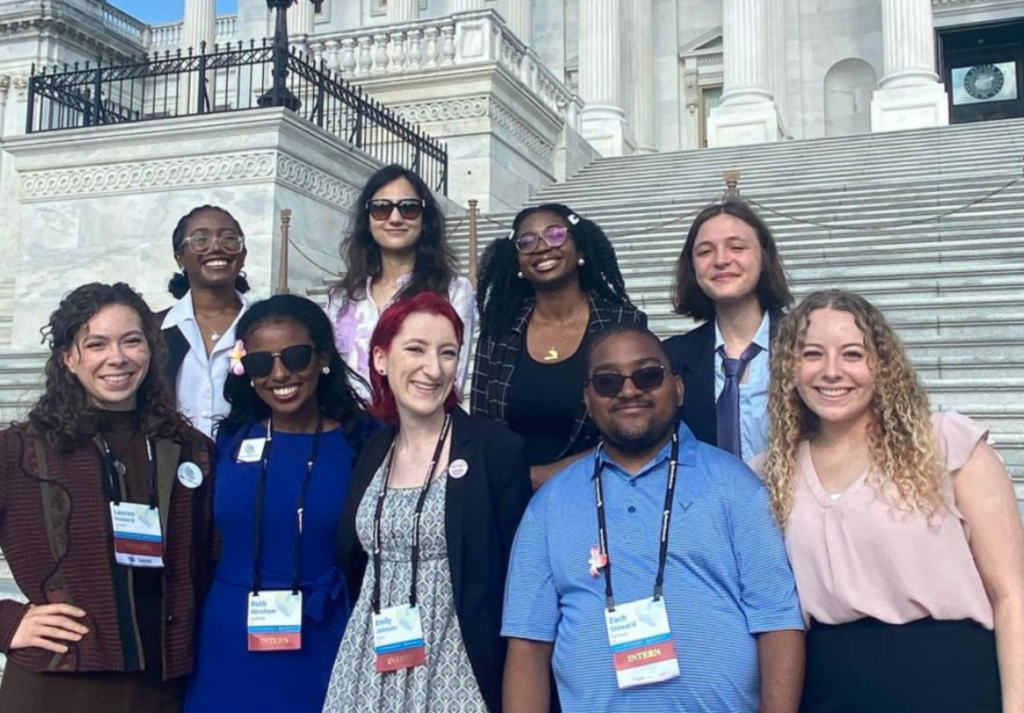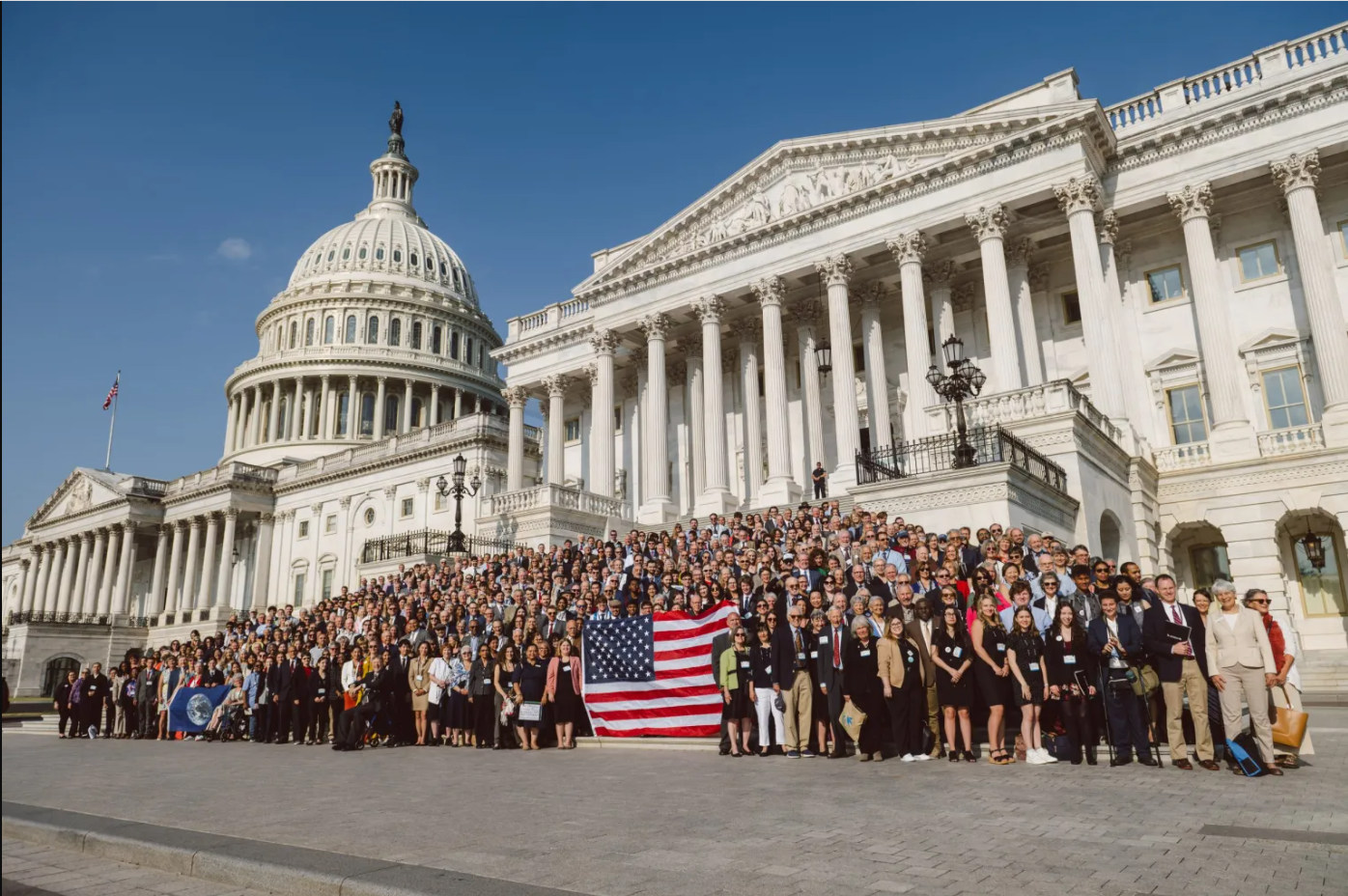Written by: Daisy Simmons
Climate policy is an important tool in tackling climate change. And you don’t need to be an elected official to get involved — you can make an impact just by talking to one. By lobbying your federal, state, or local representatives, everyday citizens can help advance climate legislation, one informed and well-organized conversation at a time.
To lobby means to seek to influence; in the case of climate lobbying, your goal might be to explain why you think your representative should support a climate-related bill targeting anything from pollution reductions to clean infrastructure.
Formal training is not a prerequisite to lobbying, but some expert guidance can help. So we requested pro tips from nonprofit Citizens’ Climate Lobby’s Danielle Whyte, who regularly trains volunteers on how to talk to their members of Congress. And to get perspective from the other side of the lobbying table, we asked former California Assembly member and Sen. Hannah-Beth Jackson for her insights, too.
Tips for a successful climate lobby meeting:
1. Take heart.
Asking to meet may take some courage. Stoke it by recognizing the strength of your purpose and the value of personal connection.
“Your political representatives are just as human as you are,” Whyte said. “They care about their loved ones, their interests, and their passions. Think of lobbying as a heart-to-heart conversation rather than something intimidating.”
There are many ways to participate in a lobbying meeting, no matter what type of personality you have. Introverts might excel as note-takers, for example.
2. Team up.
Both Whyte and Jackson advise against going it alone.
“There really is strength in numbers,” Whyte said. “Elected officials are constantly on the move, and their schedules are incredibly tight. They are far more likely to agree to meet if they know they’ll be hearing a diversity of stories.”
That’s especially true for those with large constituencies, like the district including Santa Barbara, California, where Jackson held her tenure. “You can’t have a million people coming into your office,” she said. “But you can and do meet with constituents when they’re part of a group that is respected in your district.”
3. Request a meeting.
Go to your elected representatives’ website. Most include information about how to connect with them or with their staffers. If you’re not sure who your representatives are, search here by address for federal, state, and local officials.
In some cases, you’ll find clear information on how to schedule a face-to-face. Other times, you’ll need to submit an email form or call a general office number. Take some time to figure out the local ropes. Understand that you won’t always be able to meet with the elected representative directly.
“It’s important to remember legislators’ time is very short,” Jackson said. “In California, we handle 2,000 bills every session, so our availability for meeting is very limited and you have to anticipate that things change at the very last minute. Be prepared for the possibility that you’ll meet with a staffer instead, so do your homework to know who on staff handles environmental issues.”
4. Define your ask, then tailor it.
Many citizen lobbyists organize their asks around a particular piece of legislation. If you don’t have a specific bill you’re already organizing around, then survey your community to learn which climate issues are most pressing for them. Is there an urgent need for cleaner air or more green public transportation? Is fire or flood safety a hot-button issue?
Once you’ve identified your overarching issue, build out the key points of what you’re asking for, including why it matters specifically to your representative.
“Find the way you connect your purpose with their passion,” Whyte said. For example, if jobs are one of their priorities, play up the potential economic benefits of what you are asking for, like how solar jobs are one of the fastest-growing career paths.
Equally vital, says Jackson, is to show you are not just voicing your own opinion, but that of a larger community that elected officials would want to know about. “If you have data, polling, or other ways to show the support that exists for your position, bring it,” Jackson said. “The bottom line is to personalize this as much as you can without getting too personal.”
Finally, be aware of potential pushback or weaknesses in your position so that you can be ready and willing to respond.
5. Read up on the elected official and staff.
Learn about who you’re meeting and avoid assumptions.
Jackson represents an area that’s seen catastrophic wildfires in the last few years, so meetings on the topic are common. Having served on the emergency management committee her entire legislative career, she knows a lot about the subject. She can tell when someone hasn’t done their homework.
“When someone comes in to talk to me and starts giving me the basics like they’re educating me, that doesn’t sit well,” she said. “You have to know what they know and what they don’t know.”
Apply this thinking with key staffers, too. “Oftentimes the legislator is going to rely heavily on the expertise of their staff,” Jackson said. “Make sure you read up on [both the staffers and the legislators themselves] in advance, then give [the staffer] a heads-up on … your high-level points, so they know what the issue is.”
6. Organize your meeting.
Most lobbying meetings are pretty short: 30 minutes or less. “A well-organized meeting is half the battle,” Whyte said. Punctuality and organization are vital. She recommends laying out a schedule with a clear start and end time.
7. Prepare materials.
Arm yourself with a few key visual aids to help keep your ask fresh after the meeting. At a minimum, prepare and print out a one-pager outlining what you are asking for. Extra credit: letters from their constituents, such as thank-you cards for past environmental policies they’ve helped with, notes from youth saying why the environment matters to them, and constituent letters explaining how the issue affects them personally really go a long way. “It can be really powerful to have letters from your constituents, especially some of the younger ones,” Whyte said.

8. Mind your manners.
It might seem obvious, but it must be said: Be on time. Better yet, get there early.
9. During the meeting, stick to an agenda (as best you can).
Citizens’ Climate Lobby volunteers follow a general model that begins with a short round of intros (your name, neighborhood, occupation, and brief climate impact statement.)
Next comes an appreciation of your elected official. “Have they done meaningful climate work already? Thank them for that,” Whyte said. “Or perhaps they are doing good work that is adjacent to climate issues — show some appreciation for that, instead.”
“Try to establish a nice rapport going in. Say you know they’re busy, so you appreciate the work they’ve done in the past on a particular issue.” Jackson said. “It’s also nice for them to hear if you supported them, walked precincts for them, or are a volunteer with a shared community group contact. If you have a connection in common who passes their regards, share that.”
From there, the designated timekeeper of your group should ask how much time you have today. Doing so conveys respect for their time while helping you block out the meeting in your mind, Whyte said. If you only have 20 minutes but thought you had 45, you can proceed knowing you’ll need to leave out some details and reach certain milestones in, say, five-minute increments versus 10 minutes. Move into your ask and keep it conversational. Whyte recommended using open-ended questions to help guide the discussion. For instance, you might ask where they stand on the issue and which aspect of this bill is most important to them.
10. Read the room with active listening and respect.
Every meeting is its own adventure, but listening and respect are always in order. Consider the following scenarios.
In one, things are going great, and your representative has enthusiastically agreed to your primary ask. Great! Thank them, ask if there’s a way your group can help build support from their colleagues in the vote, and then move on to a secondary ask.
In another, they’re hedging. Dig into their hesitation. What improvements would they want to see in order to support it? Can your group help address that concern? Or do they have questions you haven’t yet considered? Be honest; say you’ll look into it and will get back to them after the meeting.
For scenario three, let’s say you can tell you don’t see eye-to-eye on an issue. Maybe you knew that going in. As long as you approach the meeting with an underlying commitment to respect, this is still an opportunity, Whyte said, even if you don’t necessarily win over their vote. For starters, you’ll get a clearer sense of their priorities, giving you the opportunity to share some other aspects of the bill that they might like. You can also come to future meetings with an ask that’s better aligned with their concerns.
Whyte also said there’s always room for further education on both sides. “Take a moment to pause and reflect on what other interests your representative might have that are at stake or jeopardized by the climate crisis,” she says.
Knowing this gives you a chance to look at what climate bills might align with their core passion. For instance, if they’re concerned about small businesses, you might talk about how building electrification and energy efficiency could help those businesses save money.
“It’s so important to make that connection between their climate and their passion,” Whyte said.
In any scenario, ask how your team might support them. Can you help them spread the word in the community? Can you pull together more data?
11. Say thanks and goodbye.
Thank them for their time, representative or staffers alike. Leave them with your one-pager and contact information, and let them know when you’ll follow up.
12. After your meeting, debrief with your team.
“Take a moment with your lobby group to reflect on what you just talked about,” Whyte said. Did the representative need more information about something or seem stuck on a particular point? Talk through the key points taken by your note-taker, making sure you capture everyone’s impressions while they’re still fresh.
13. Don’t stop there.
It often takes more than one lobby meeting to move an elected official toward the position that you want them to have. Follow up with the elected official or staffer, drawing from your notes.
Lobbying is most powerful when you build from meeting to meeting. Take your lessons learned, go back out into the community to ask new questions, and monitor related policies so that you have fresh insights to share when you do meet again.
Pushing the needle on climate policy
These tactics apply whether you’re meeting with a local, state, or federal representative. In the end, it’s all the same formula,” Whyte said. “It’s about respect, active listening, and open-ended communication.”
You won’t always come out of a meeting with a promise to support your cause, but you will come out knowing you’ve helped promote climate leadership in your community.
This article originally appeared on Yale Climate Connections







